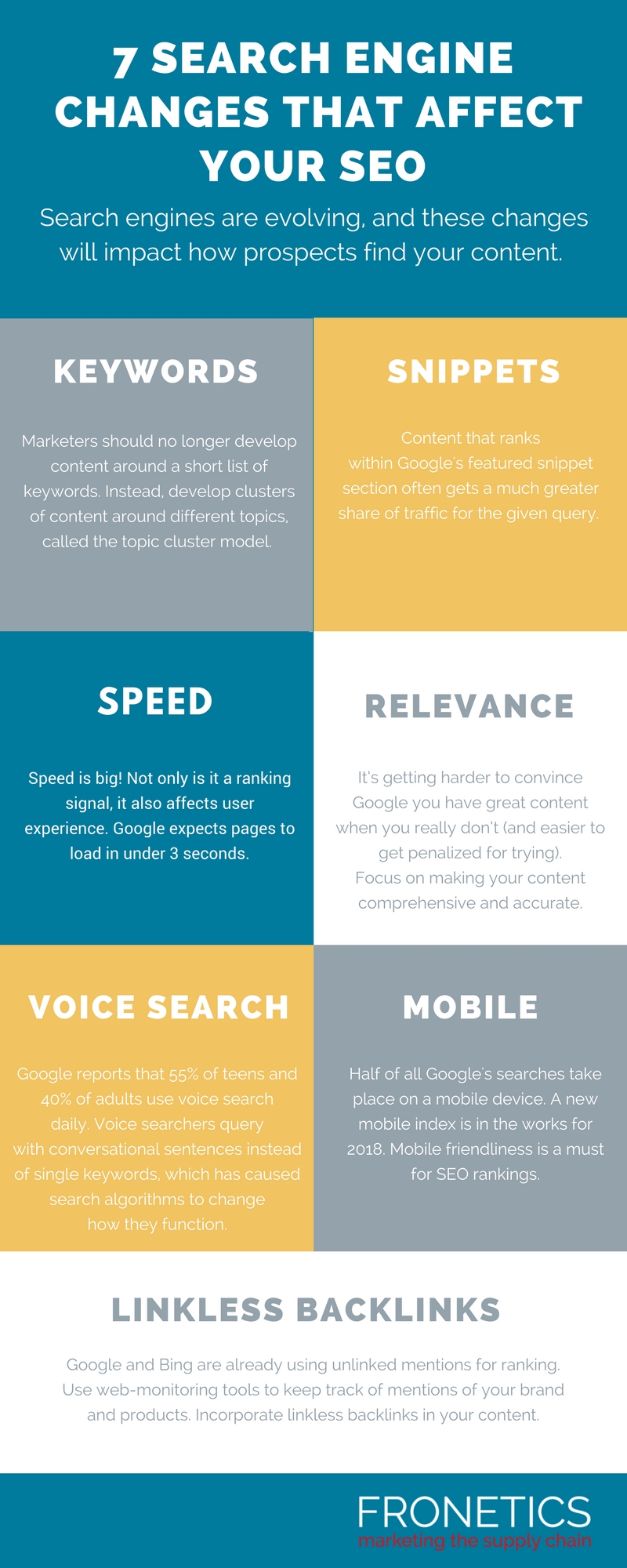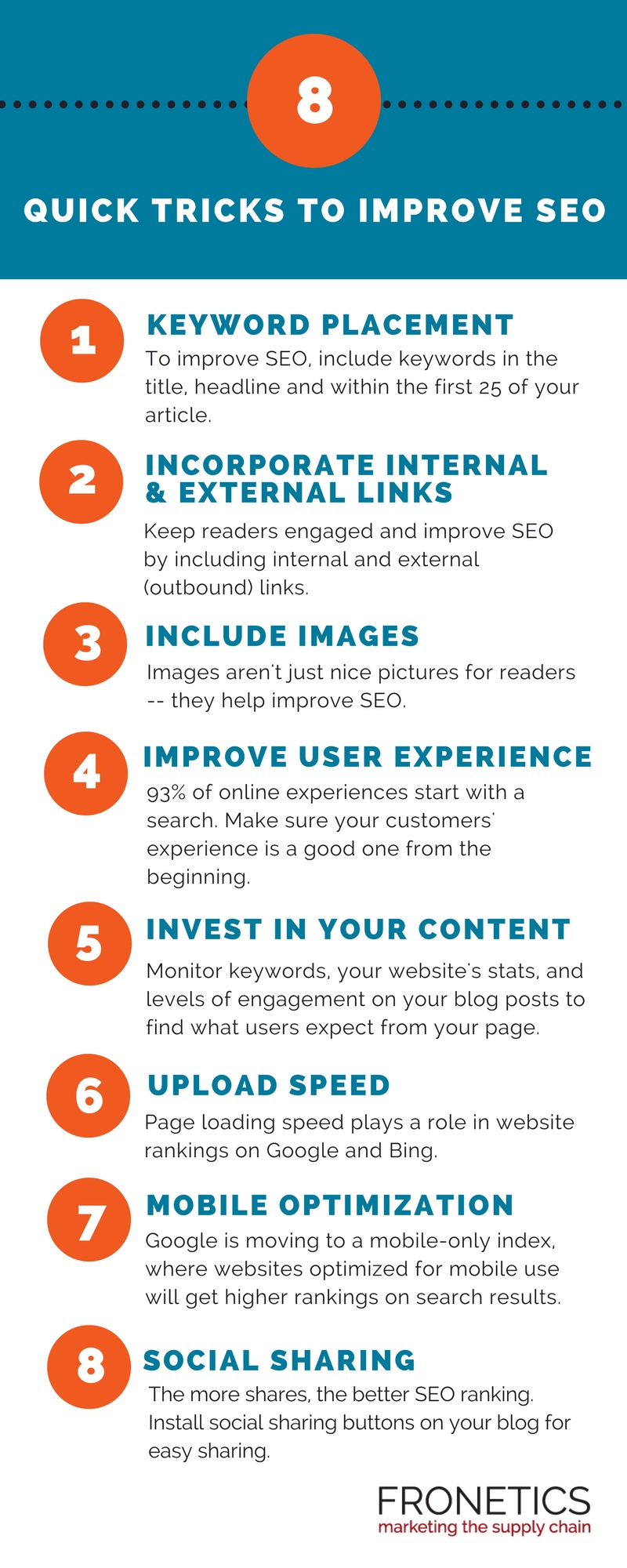
by Fronetics | Feb 19, 2018 | Blog, Content Marketing, Logistics, Marketing, Supply Chain
Search engines are evolving, and these changes will have big impacts on how searchers find your content. Here are 7 changes that will affect your SEO.
Internet users are changing how they search, and in response, search engines are changing how they rank content. Newer, more sophisticated algorithms have had big impacts on SEO rankings and the changes haven’t stopped there. Search engines are working around the clock to improve how content ranks for their users. Google and Bing want to ensure its readers are getting the quality content they deserve.
What does this mean for your SEO? It can be very challenging to understand all of the factors that go into a search engine’s algorithm for rankings. Google has over 205 factors that play a part in determining where you content lands in a search and they’re always changing. Instead of worrying about all of those components, here are 7 changes that have big impacts and are easy to integrate into your content.
7 search engine changes you need to know: infographic

Changes to the way search engines work do present a challenge for content creators writing for SEO. But keeping pace with the ever-changing technology is key to keeping your content relevant. Keeping these 7 key changes in mind, content writers can work to integrate these changes into their new content, as well as update older content.
Ultimately, the best way to improve your SEO is through your content. Quality content that is valuable to your target audience should be your biggest priority. With good content and keeping these 7 changes at the forefront, you will be able to optimize your posts and increase the likelihood internet searchers will find them.
Related posts:


by Fronetics | Feb 13, 2018 | Blog, Content Marketing, Logistics, Marketing, Supply Chain
Here are three tips for writing pillar content that will help structure your posts, attract leads and gain better page rankings.
In case you missed our series on writing for SEO, pillar content is a highly effective way to define your brand, drive traffic, and convert website visitors to leads. But in order to be effective, these pages should be strategically designed to do their proper job in telling search engines what your site is all about.
Before we go further, let’s take a step back and talk about exactly what pillar content is. As search engines adjust their algorithms to favor topic-based content, savvy marketers are turning to topic clusters to structure their content.
“This method uses a single pillar page as the main hub of content for a given topic. All of your content assets related to that topic link back to the pillar page,” explains HubSpot blogger Amanda Zantal-Wiener.
Need some ideas for writing and structuring effective pillar content? Here are three tips to get you started.
3 tips for writing pillar content
1) Start thinking about your site differently.
Not so long ago, SEO optimization was all about keywords. But search engines are changing. As their algorithms get more sophisticated, they look for websites that can provide depth and breadth on a particular topic. That means topic-based content wins you better page rank. It’s time to start thinking about your site as a collection of topics rather than a collection of keywords.
2) Consider your core audience.
“Think about the top interests and challenges of your core audience personas to give you ideas for pillar page content,” says HubSpot blogger Sophia Bernazzani.
Good content marketing is all about cultivating your reputation as a trusted resource for your audience, and pillar pages are no exception. Chose topics that answer the needs of your target audience. Topics should be broad enough to be able to generate multiple related blog posts, but narrow enough that you can cover all related content on a single pillar page.
3) Your content is about answering questions.
“Pillar pages should answer any question or query a searcher might have about a topic — which will make them want to click on your pillar page when they enter a Google search term that your page ranks for,” writes Bernazzani. The goal is to draw site visitors with savvy pillar content, and let them explore all content in your topic cluster.
Related posts:


by Fronetics | Feb 5, 2018 | Blog, Content Marketing, Marketing
Internet users are changing how they search, and search engines are changing in response — which means writing for SEO is changing, too. Here’s what you need to know.
I’ve just completed a really detailed, often-complicated series about writing for SEO in today’s changing search landscape. I hope you read all four posts and now have a better understanding of the new way we marketers are thinking about content marketing.
But, as my colleagues occasionally have to remind me, not everyone enjoys the nitty gritty of SEO writing like I do. It’s also important to step back and take a look at the forest after examining the trees.
So here are some really important takeaways from the series — about how internet users, search engines, and writing for SEO are changing — that I think are important for all marketers in the supply chain and logistics industries.
4 things to know in a changing search landscape
1) Search engines are changing.
While keyword rankings used to be the gold standard for measuring SEO success, this is no longer the case. New search algorithms have moved beyond giving everyone the same results of a query, meaning that keyword ranking can change drastically depending on context (like location).
In addition, Google is increasingly showing featured snippets at the top of search results.
What you need to do:
Know that measuring SEO success is no longer as simple as keeping track of keyword rankings. It’s still information worth having, but it’s part of a larger set of metrics you need to evaluate your success and tailor your efforts.
To effectively take advantage of featured snippets, it’s important to structure your content so it’s optimized to appear in this prime location.
Read the full post.
2) People are changing how they search.
Because of the rise of mobile and voice search, people are now searching with a phrase or question rather than a single term. In response, search engine development has focused on natural language processing — meaning search engines now analyze phrases as a whole rather than a keyword. That essentially means they evaluate a site’s content regarding an entire topic rather than its use of a particular word in order to deliver the best answers to users’ queries. Basically, we’re looking at the same issue as the last post, but from the user end.
What you need to do:
Stop trying to rank for a small set of keywords. What’s important is broad visibility across a topic. You should start thinking about the major themes of your content and then build posts and website pages to support them.
Read the full post.
3) Structure your content in topic clusters and pillar content.
Pillar content is your evergreen content that offer a high-level overview of the several ideas/phrases/value propositions that most closely align with your brand. Topic clusters are the subtopics that provide more detail on those high-level ideas of your pillar content. Adding hyperlinks to pillar content pages from topic cluster pages and vice versa creates a structure that signals to search engines that your site has lots of good, well-organized information about a certain topic, which improves ranking across that topic.
What you need to do:
Structure your content into pillar content and topic clusters. Add hyperlinks between the pages. Optimize topic cluster pages to drive traffic and pillar content pages to convert leads.
Read the full post.
4) Measure the success of your content.
Measuring success is getting more complex. You can no longer effectively gauge the effectiveness of campaigns on a post-by-post basis. Instead, measure your visibility across each topic.
What you need to do:
Start looking at the bigger picture. Consider how all content under each cluster topic performs as a whole. As you do this, keep the big four questions in mind:
1) Which topics perform best at driving traffic to your website or other web presence?
2) Which topics earn you the most leads?
3) Which topics drive the most revenue to your business?
4) Which topics earn the most backlinks/coverage?
Read the full post.
Related posts:


by Fronetics | Jan 29, 2018 | Blog, Content Marketing, Logistics, Marketing, Supply Chain
Use these 8 quick tips in your blog posts to improve SEO and help your target audience find your content.
Search engine optimization: It’s a phrase every blog writer looking to grow readership has wrestled with at one time or another. Part science, part art, SEO writing can evade even the most seasoned blogger. You want people searching the internet to find your blog, but you also want readers to enjoy your posts and not feel like they’re written for machines.
Search engines continue to evolve and improve their algorithms to make sure readers are finding exactly what they’re looking for. Never artificially stuff your posts with keywords, links or images. Search engines, like Google, penalize webpages that use sneaky techniques, like keyword stuffing, by demoting or even removing their pages from their indexes.
Ultimately, if you want to improve your SEO, your content needs to be value to your target audience. That should be your priority when planning and producing content like blog posts. But you can also keep these quick tricks in mind to optimize your posts, and thus increase the likelihood internet searchers will find them in the first place.
Infographic: 8 quick tips for blog posts to improve SEO

(Made with Canva)
Using these 8 quick tips will improve SEO and get your blog posts in front of your target audience. Remember, your best bet on moving up on search engine results pages is to create content that readers want to read. Sounds simple, I know, but it can be challenging. Let us know how these tips helped improve your SEO.
Related posts:

SaveSave

by Fronetics | Jan 25, 2018 | Blog, Content Marketing, Marketing
Why is no one reading your blog? Chances are, you’re not doing it right. Here are some of the blog writing mistakes you may be making.
There is so much content out there. In fact, the U.S. alone generates 2,657,700 gigabytes of internet data every minute. Every minute! That’s a whole lot of videos, tweets, posts, and photos being shared online. No wonder no one is reading your blog.
There’s so much competition out there, it’s hard to stand out against those numbers. Even with the time and energy you’re putting into your blog, you’re not seeing the views and engagement you were hoping to achieve.
Most likely, you are making one of these mistakes. Here are some reasons why no one is reading your blog.
10 reasons why no one is reading your blog: an infographic

(Made with Canva)
Related posts:

SaveSave
SaveSave
SaveSave
SaveSave









